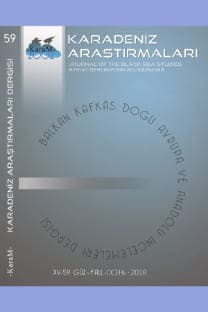Osmanlı Tarihçisi Mustafa Naima’nın Metin Bütününde Bireysel Üslubu
Osmanlı Kroniği, Osmanlı Türkçesi Düzyazı, Mustafa Naima, Bireysel Üslup, Korpus Dilbilimi.
OTTOMAN CHRONICLER MUSTAFA NAIMA’S INDIVIDUAL STYLE IN CORPUS DIMENSION
___
- GUADALUPE J.T. vd. (2008) “Similarity Measure for Clustering and its Ap- plications”, Proceedings of World Academy of Science, Engineering and Technology, 31: 490-496.
- GUIRAUD P. (1953). Langage et versification, Paris: Klincksieck.
- GÜRIŞIK Bihter (2005). Peçevi tarihi (46b/80a metin, dizin, özel adlar sözlüğü), Marmara Üniversitesi, Türkiyat Araştırmaları Enstitüsü, İs- tanbul (Yayımlanmamış Yüksek Lisans Tezi).
- HAGEN Gottfried (2006). Osman II and the Cultural History of Ottoman His- toriography.
- http://www.h-net.org/reviews/showrev.php?id=11651 (04.02.2018). HUANG A. (2008). “Similarity measures for text document clustering”, Proceedings of NZCSRSC 2008: 49–56.
- KARADAYI Aynur (2008). Osmanlı tarih yazıcılığının gölgede kalmış bir eseri "Tarih-i Sâmî" (metnin transkripsiyonu), Adnan Menderes Üniversitesi, Sosyal Bilimler Enstitüsü, Aydın (Yayımlanmamış Yüksek Lisans Tezi).
- MacENERY T. (2001). Corpus Linguistics: An introduction, Edinburg Uni- versity Press.
- ISSN: 2536-5126
- Yayın Aralığı: 4
- Başlangıç: 2004
- Yayıncı: Osman Karatay
TİFLİS ARŞİVİNDE KİTAB-I CELALÎ KÖROĞLU
AHISKA’NIN TÜRKİYE İÇİN JEOPOLİTİK ÖNEMİ
ORTAOKUL 6, 7 VE 8. SINIF TÜRKÇE DERS KİTAPLARINDAKİ METİNLERİN DEĞER EĞİTİMİ AÇISINDAN İNCELENMESİ
Ayla YILDIZ, Fırat YOLCU, A. Şahin KILIÇ
Osmanlı Tarihçisi Mustafa Naima’nın Metin Bütününde Bireysel Üslubu
İNGİLİZ TİCARET RAPORLARINDA (1908-1913) TRABZON
ORDU/ÜNYE ŞEHİR İÇİ HANLARINDAN GÜNÜMÜZE KALAN TEK ÖRNEK: KEFELİ HAN
ÇERKES TOPLUMUNDA BİR HAFIZA MEKÂNI OLARAK ZEHES
